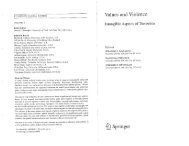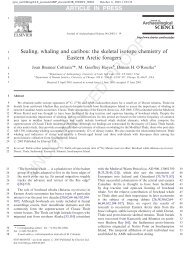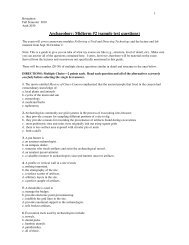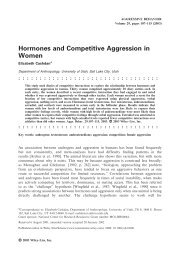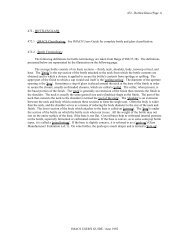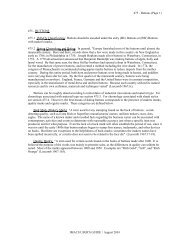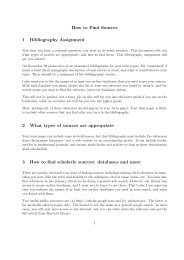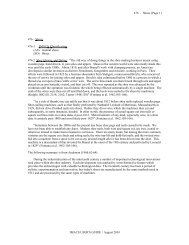474 - Cartridges (Page 1) IMACS USER'S GUIDE / June 1992 474 ...
474 - Cartridges (Page 1) IMACS USER'S GUIDE / June 1992 474 ...
474 - Cartridges (Page 1) IMACS USER'S GUIDE / June 1992 474 ...
Create successful ePaper yourself
Turn your PDF publications into a flip-book with our unique Google optimized e-Paper software.
<strong>474</strong> - <strong>Cartridges</strong> (<strong>Page</strong> 1)<br />
<strong>474</strong> - CARTRIDGES<br />
<strong>474</strong>.1 <strong>IMACS</strong> Classification :<br />
(AM) Ammunition<br />
(AW) Ammunition with maker's marks<br />
<strong>474</strong>.2 <strong>Cartridges</strong> and Dating : "A wealth of information on dates of cartridges occurs and is very useful.<br />
Only the initial dates of cartridges and guns are useful (when present), however, since guns were used for<br />
many years after their original purchases. <strong>Cartridges</strong> are discrete sources of information of bewildering<br />
complexities, part of which is related to 'wild cat' (off-brand or modified cartridges) and to great varieties in<br />
cartridges which have been available. One factor to be considered is reloading of centerfire cartridges which<br />
has been very common. Rimfire cartridges, conversely, are not normally reloaded (Barnes 1972:271). Both<br />
rimfire and centerfire cartridges owe their mass produced geneses to between 1856 and 1858 (although they<br />
had been produced earlier in very limited amounts), according to Barnes (1972:69 and 271). Standard<br />
centerfire cartridges with self-contained primers were innovations of approximately 1868 mass productions<br />
and continue to the present" (Buckles et al. 1978:445-446).<br />
"Most cartridge identifications must be made from measurements, as few had identifying head stamps.<br />
For identification purposes we refer to <strong>Cartridges</strong> of the World (Barnes 1972), American Centerfire<br />
<strong>Cartridges</strong>, 1892-1963 (Bearse 1966) and <strong>Cartridges</strong> - A Pictorial Digest of Small Arms Ammunition<br />
(Logan, 1959). Unidentifiable cartridges can be referred to local gunsmiths who are often eager to aid"<br />
(Buckles et al. 1978:430).<br />
"<strong>Cartridges</strong>, or rather metallic cartridge cases, are usually prevalent in southwestern historical sites,<br />
particularly those of the nineteenth century. The headstamp markings provide a convenient means of dating<br />
the cases" (Berge 1980:219).<br />
"The flat part of the head is usually stamped with the caliber type, manufacturer's name or initials, and<br />
sometimes trade names American military cartridge case heads usually have the initials of the arsenal or<br />
ordinance plant where manufactured, plus the last two numbers of the year the particular cartridge was made.<br />
For example, a head stamp that reads 'F 87 R 3' indicates that the case was made at the Frankford Arsenal<br />
(F) in March (3), 1887 (87) for a rifle (R)" (Berge 1980:223).<br />
Logan (1959:189-192 and 204) identifies the following manufacturers of headstamps found in the<br />
southwest: (Berge 1980:223-224)<br />
DM<br />
Des Moines Ordinance Plant<br />
DWM<br />
Deutsche Waffen & Munitions Fabriken (Germany)<br />
F; F.A. Frankford Arsenal (U.S.)<br />
F. (impressed) Federal Cartridge Co. (rimfire cartridge cases)<br />
F.V.V. & Co.<br />
Fitch, Van Vechten & Co., New York City.G. Jacob Goldmark,<br />
New York (Metallics)<br />
<strong>IMACS</strong> <strong>USER'S</strong> <strong>GUIDE</strong> / <strong>June</strong> <strong>1992</strong>
<strong>474</strong> - <strong>Cartridges</strong> (<strong>Page</strong> 2)<br />
H. Winchester Repeating Arms (rimfire cartridge cases). In 1866,<br />
the New Haven Arms Co. was reorganized into Winchester<br />
(1867-present).<br />
H. (raised) Winchester Repeating Arms (rimfire--early manufacturing).<br />
P. (raised) Phoenix Cartridge Co.<br />
P. (impressed) Peters Cartridge Co. (1887-1934 absorbed by Remington).<br />
PC CO.; PETERS<br />
Peters Cartridge Co.<br />
RA: RaUMC; REM-UMC Remington Union Metallic Cartridge Co. (1902-present).<br />
RW<br />
Winchester Repeating Arms Co. (rifle).<br />
U;UMC<br />
Union Metallic Cartridge Co. (before the merger with<br />
Remington--1867-1902).<br />
U<br />
Utah Ordnance Plant<br />
U HiSpeed<br />
Remington UMC (on rimfires since WWII)<br />
U.S.; USC Co. United States Cartridge Co. (1868-)<br />
US (raised)<br />
United States Cartridge Co. early.<br />
US<br />
United States Cartridge Co. (intertwined like a $ sign).<br />
WRA: WRA CO;<br />
Winchester Repeating Arms Co.<br />
Super Speed<br />
W; W Co.; WCC; Western Cartridge Co. (1898-present).<br />
WESTERN Super-X<br />
1901 NEW RIVAL; Winchester Repeating Arms Co.<br />
1901 LEADER;<br />
1901 REPEATER;<br />
1901 PIGEON<br />
<strong>474</strong>.3 Pertinent Notes for Recording <strong>Cartridges</strong> :<br />
If cartridge cases are observed with a stamp on the flat part of the head, then these markings (i.e.,<br />
stamps) should be described and drawn. These stamps can then be identified upon return to the laboratory<br />
by comparison with various references (especially those noted in this section). Dating of cartridge cases is<br />
based on the time length of manufacture by a specific company (e.g., Peters Cartridge Co. (1887-1934), or<br />
upon the date on the cartridge case. If the observed cartridge cases do not have stamped heads, then general<br />
dates can be ascribed from the technique of manufacture. The development of the various cartridge types is<br />
outlined in Berge (1980).<br />
<strong>474</strong>.4 Measurement of Cartridge Calibers:<br />
"The Americans and British measure the cartridge caliber in 100th's or 1000th's of an inch, the caliber<br />
being designated by any one of the following criteria (Bearse 1966:15):<br />
<strong>IMACS</strong> <strong>USER'S</strong> <strong>GUIDE</strong> / <strong>June</strong> <strong>1992</strong>
<strong>474</strong> - <strong>Cartridges</strong> (<strong>Page</strong> 3)<br />
1) Bore or diameter of the barrel.<br />
2) Barrel-groove diameter.<br />
3) Bullet diameter.<br />
4) Inside diameter of cartridge case mouth.<br />
5) Arbitrary figure, determined by manufacturer.<br />
The caliber may be designated by many means, as listed, and may include the case length or case type.<br />
The measuring of a cartridge case with calibers in order to determine specific measurements of given places<br />
on the metallic case may prove to be of more value than cartridge-type collections. Many books such as<br />
Barnes (1965) give detailed listings of cartridge case measurements which identify a cartridge case very<br />
accurately" (Berge 1978).<br />
<strong>IMACS</strong> <strong>USER'S</strong> <strong>GUIDE</strong> / <strong>June</strong> <strong>1992</strong>



